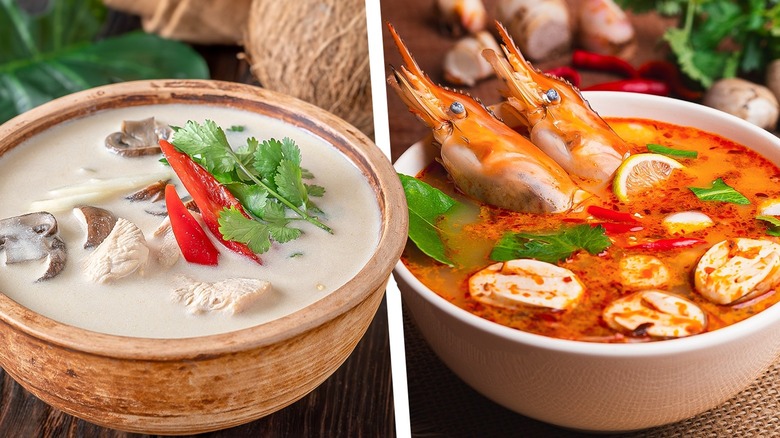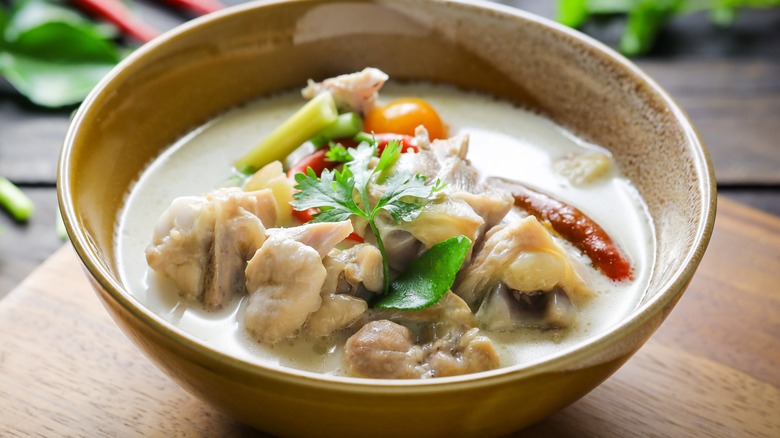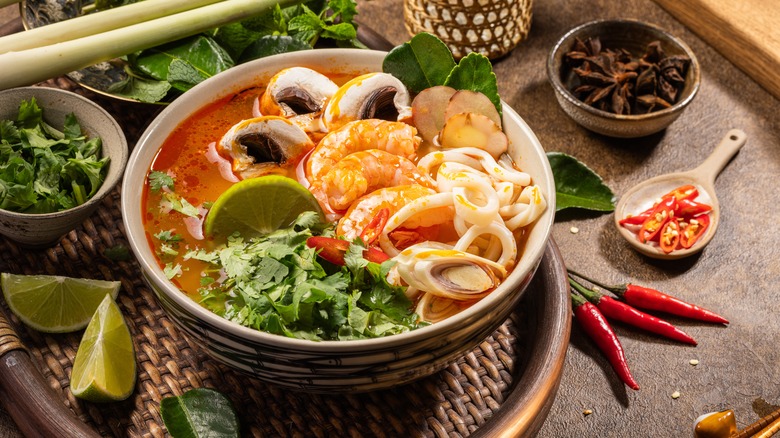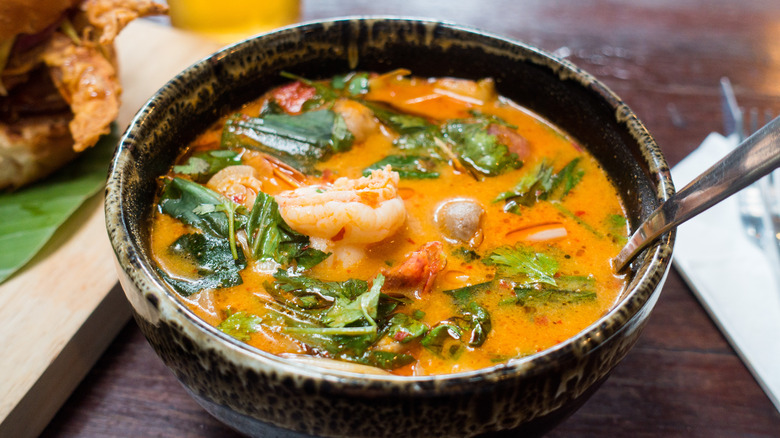Tom Yum Vs Tom Kha Soup: What's The Difference?
When you sit down to dinner or pick up a takeout menu at your favorite local Thai restaurant, chances are you probably have a go-to order. We love pineapple pad Thai and panang curry as much as the next foodie, but zoom over to the "soup" section of the menu and there are even more flavorful wonders to taste — and to unpack. What exactly is the difference between two classic Thai dishes: tom yum and tom kha soup?
"Tom yum" roughly translates to "boiled medley" in reference to the toothy, relatively large pieces of protein, veggies, and aromatics bobbing in the fragrant broth. But "tom kha" translates to "boiled galangal," and this soup is also composed of a medley of ingredients. Both soups are warming, comforting, nourishing, and ultra-dimensional flavor-wise. They can also both be enjoyed as a soup or served over jasmine rice or rice noodles. The latter serving method can also be a great way to make leftovers stretch, for the record.
The largest differences between earthy-tangy tom yum and sweet-spiced tom kha are their flavor profiles and spiciness levels. For starters, perhaps unsurprisingly, galangal plays a huge role in the taste of tom kha, where salty-umami fish sauce meets the citrus zing of fresh lime juice. Tom kha takes comfort food chicken soup to a delicious new level, and in tom yum, it's all about spicy shrimp.
What is tom kha soup?
Tom kha (aka tom kha gai) is a light, creamy, traditional Thai soup with chicken, coconut, and galangal. If you've never worked with it before, galangal is a flavorful root in the ginger family. Compared to sharp-sweet ginger, galangal tastes citrusy and piney, deepened by a sharp dryness. In tom kha, galangal joins a layered bouquet of aromatics alongside lemongrass, shallots, makrut or kaffir lime leaves, and dried Thai or bird's eye chiles. Pro tip: Makrut leaves can be found in the freezer section of most Asian grocery stores. If you can't track 'em down, you can substitute fresh lime juice and a leafy green garnish like cilantro.
These flavorful, diverse aromatics swim in a base of chicken broth and coconut cream or full-fat unsweetened coconut milk for an herbaceous, savory bite. Tom kha is all about creaminess meeting sour and salty flavors, plus the balance of sweet, rich coconut cream and the cut of galangal. To complete this elevated chicken soup recipe, tom kha is bulked up with onions, tomatoes, white mushroom caps or oyster mushrooms, and whole aromatics floating in the complex broth. For a quick dinnertime shortcut, you can even whip up a stripped-down three-ingredient tom kha with chicken noodle soup, fish sauce, and canned coconut milk.
What is tom yum soup?
Tom yum (aka tom yum goong) is a sour, spicy, tart, and tangy Thai shrimp soup. Like tom kha, tom yum is also loaded with lemongrass, galangal, makrut lime leaves, and Thai or bird's eye chiles in the aromatics bundle. But unlike tom kha, tom yum is a seafood-forward soup with whole shrimp and shrimp paste, packing bold seafood flavor and major chile spice. Tom yum also often includes nam prik pao paste (aka chile jam), a savory spread made with garlic and tamarind.
The shrimp bob in a base of chicken stock or vegetable stock, which makes for a thinner broth compared to silky tom kha. Although, some variations of tom yum add a splash of coconut milk for creaminess. In general, though, tom yum is coconut-free. Since there's no sweetness from coconut cream to be found here, in tom yum, a sprinkle of brown sugar or palm sugar is added to counterbalance the soup's sourness and bitterness, as well as to temper the spicy intensity of the chiles. Beside the shrimp, tom yum is further bulked up with vegetables like shallots, zucchini, halved cherry tomatoes, and mushrooms, especially shiitake and straw mushrooms.
Tom yum is tangy-spicy and made with shrimp, and tom kha is sweet-spiced and made with chicken
The biggest differences between tom yum and tom kha soups are their proteins, spiciness levels, and overall flavor profiles. The dominant flavors in tom kha are coconut, chicken, and galangal, while the dominant flavors in tom yum are lemongrass, lime, and shrimp. Their proteins are also different, with tom yum typically being made with whole head-on shrimp and shrimp paste and tom kha being made with chicken. The shrimp and chicken are cooked directly in the broth in both soups. Technically, either soup can be made with different proteins such as pork or tofu (like this tofu tom yum soup recipe), but these variations are not traditional.
Tom kha is also milder than tom yum. In satiny tom kha, any spiciness comes from the hint of bird's eye chile or the sharpness of the galangal. Tom kha is also made creamier by its coconut milk, while only some versions of tom yum include coconut at all. Tom yum, by contrast, is a markedly spicy soup loaded with chili-forward flavor. The lack of coconut milk is also largely responsible for tom yum's deep orange hue compared to tom kha's pale beige color.



